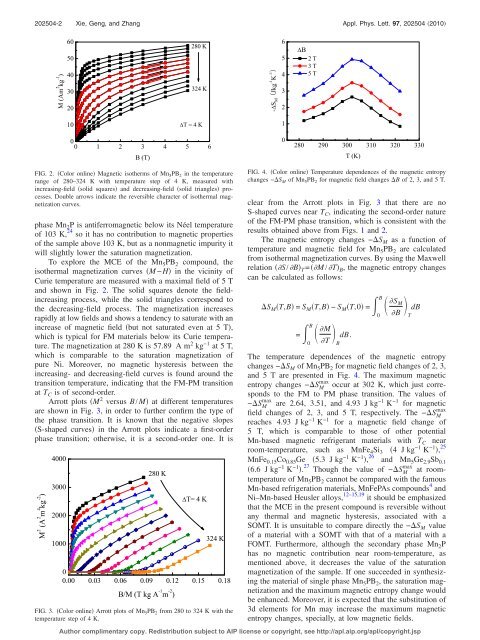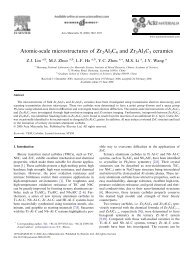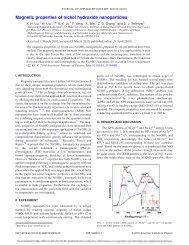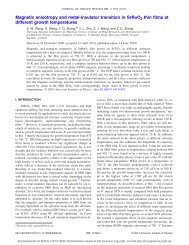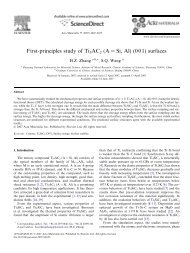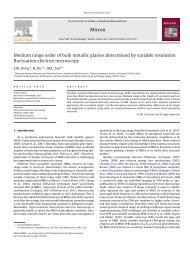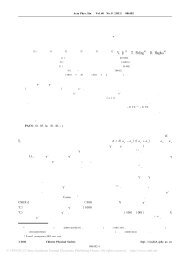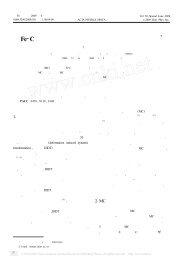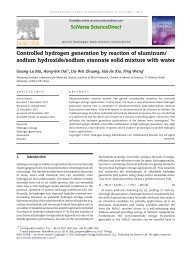Reversible room-temperature magnetocaloric effect in Mn5PB2
Reversible room-temperature magnetocaloric effect in Mn5PB2
Reversible room-temperature magnetocaloric effect in Mn5PB2
Create successful ePaper yourself
Turn your PDF publications into a flip-book with our unique Google optimized e-Paper software.
202504-2 Xie, Geng, and Zhang Appl. Phys. Lett. 97, 202504 2010<br />
FIG. 2. Color onl<strong>in</strong>e Magnetic isotherms of Mn 5 PB 2 <strong>in</strong> the <strong>temperature</strong><br />
range of 280–324 K with <strong>temperature</strong> step of 4 K, measured with<br />
<strong>in</strong>creas<strong>in</strong>g-field solid squares and decreas<strong>in</strong>g-field solid triangles processes.<br />
Double arrows <strong>in</strong>dicate the reversible character of isothermal magnetization<br />
curves.<br />
phase Mn 2 P is antiferromagnetic below its Néel <strong>temperature</strong><br />
of 103 K, 24 so it has no contribution to magnetic properties<br />
of the sample above 103 K, but as a nonmagnetic impurity it<br />
will slightly lower the saturation magnetization.<br />
To explore the MCE of the Mn 5 PB 2 compound, the<br />
isothermal magnetization curves M −H <strong>in</strong> the vic<strong>in</strong>ity of<br />
Curie <strong>temperature</strong> are measured with a maximal field of 5 T<br />
and shown <strong>in</strong> Fig. 2. The solid squares denote the field<strong>in</strong>creas<strong>in</strong>g<br />
process, while the solid triangles correspond to<br />
the decreas<strong>in</strong>g-field process. The magnetization <strong>in</strong>creases<br />
rapidly at low fields and shows a tendency to saturate with an<br />
<strong>in</strong>crease of magnetic field but not saturated even at 5 T,<br />
which is typical for FM materials below its Curie <strong>temperature</strong>.<br />
The magnetization at 280 K is 57.89 A m 2 kg −1 at 5 T,<br />
which is comparable to the saturation magnetization of<br />
pure Ni. Moreover, no magnetic hysteresis between the<br />
<strong>in</strong>creas<strong>in</strong>g- and decreas<strong>in</strong>g-field curves is found around the<br />
transition <strong>temperature</strong>, <strong>in</strong>dicat<strong>in</strong>g that the FM-PM transition<br />
at T C is of second-order.<br />
Arrott plots M 2 versus B/M at different <strong>temperature</strong>s<br />
are shown <strong>in</strong> Fig. 3, <strong>in</strong> order to further confirm the type of<br />
the phase transition. It is known that the negative slopes<br />
S-shaped curves <strong>in</strong> the Arrott plots <strong>in</strong>dicate a first-order<br />
phase transition; otherwise, it is a second-order one. It is<br />
FIG. 3. Color onl<strong>in</strong>e Arrott plots of Mn 5 PB 2 from 280 to 324 K with the<br />
<strong>temperature</strong> step of 4 K.<br />
FIG. 4. Color onl<strong>in</strong>e Temperature dependences of the magnetic entropy<br />
changes −S M of Mn 5 PB 2 for magnetic field changes B of 2, 3, and 5 T.<br />
clear from the Arrott plots <strong>in</strong> Fig. 3 that there are no<br />
S-shaped curves near T C , <strong>in</strong>dicat<strong>in</strong>g the second-order nature<br />
of the FM-PM phase transition, which is consistent with the<br />
results obta<strong>in</strong>ed above from Figs. 1 and 2.<br />
The magnetic entropy changes −S M as a function of<br />
<strong>temperature</strong> and magnetic field for Mn 5 PB 2 are calculated<br />
from isothermal magnetization curves. By us<strong>in</strong>g the Maxwell<br />
relation S/B T =M /T B , the magnetic entropy changes<br />
can be calculated as follows:<br />
S M T,B = S M T,B − S M T,0<br />
B S M<br />
dB<br />
=0 B<br />
T<br />
B M dB.<br />
=0<br />
TB<br />
The <strong>temperature</strong> dependences of the magnetic entropy<br />
changes −S M of Mn 5 PB 2 for magnetic field changes of 2, 3,<br />
and 5 T are presented <strong>in</strong> Fig. 4. The maximum magnetic<br />
entropy changes −S max M occur at 302 K, which just corresponds<br />
to the FM to PM phase transition. The values of<br />
−S max M are 2.64, 3.51, and 4.93 J kg −1 K −1 for magnetic<br />
max<br />
field changes of 2, 3, and 5 T, respectively. The −S M<br />
reaches 4.93 J kg −1 K −1 for a magnetic field change of<br />
5 T, which is comparable to those of other potential<br />
Mn-based magnetic refrigerant materials with T C near<br />
<strong>room</strong>-<strong>temperature</strong>, such as MnFe 4 Si 3 4 J kg −1 K −1 , 25<br />
MnFe 0.15 Co 0.85 Ge 5.3 J kg −1 K −1 , 26 and Mn 5 Ge 2.9 Sb 0.1<br />
6.6 J kg −1 K −1 . 27 Though the value of −S max M at <strong>room</strong><strong>temperature</strong><br />
of Mn 5 PB 2 cannot be compared with the famous<br />
Mn-based refrigeration materials, MnFePAs compounds 4 and<br />
Ni–Mn-based Heusler alloys, 12–15,19 it should be emphasized<br />
that the MCE <strong>in</strong> the present compound is reversible without<br />
any thermal and magnetic hysteresis, associated with a<br />
SOMT. It is unsuitable to compare directly the −S M value<br />
of a material with a SOMT with that of a material with a<br />
FOMT. Furthermore, although the secondary phase Mn 2 P<br />
has no magnetic contribution near <strong>room</strong>-<strong>temperature</strong>, as<br />
mentioned above, it decreases the value of the saturation<br />
magnetization of the sample. If one succeeded <strong>in</strong> synthesiz<strong>in</strong>g<br />
the material of s<strong>in</strong>gle phase Mn 5 PB 2 , the saturation magnetization<br />
and the maximum magnetic entropy change would<br />
be enhanced. Moreover, it is expected that the substitution of<br />
3d elements for Mn may <strong>in</strong>crease the maximum magnetic<br />
entropy changes, specially, at low magnetic fields.<br />
Author complimentary copy. Redistribution subject to AIP license or copyright, see http://apl.aip.org/apl/copyright.jsp


